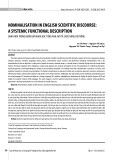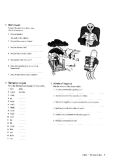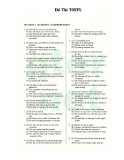
7+(:25)2507,212)6/17(50621
(1/,6+19,(710(6(62&,/0(,,1
7DQ7KL7K3KRQ
1HQDLRQ
Email:phuongttt@yersin.edu.vn
Received:05/08/2024
Revised:17/02/2025
Accepted:26/02/2025
DOI:10.59266/houjs.2025.532
EVWDFWKHVWGGHHGLQWRWKHRPDWLRQRVDQWHPVRQ(QLVKDQG9LHWQDPHVH
social media in 2023, utilizing a theoretical framework that combines the works of Yule
(2010),Meyer(2009),Schmid(2015),andLe(2023).Employingaquantitativemethodto
analyze thedata,the researchersdiscoveredseveralinstancesof variouswordformation
processesinbothlanguages.InEnglish,thisstudyfound14casesofmeaningextension,5of
acronyms,5ofcoinage,4ofclipping,3ofcompounding,1ofconversion,and1ofsyllable
change.Meanwhile,Vietnamesehad13casesofmeaningextension,8ofborrowing,8of
syllablechange,7ofcompounding,6ofmultipleprocesses,and2ofcoinage.Ultimately,this
researchaimstocontributetotheeldoflinguisticsbyexpandingourknowledgeofword
RPDWLRQSRHVVHV
.HRV:RGRPDWLRQDQWHPV9LHWQDPHVHVRLDPHGLD(QLVKVRLD
YersinUniversityofDaLat
,,QWURGFWLRQ
Word-formation research aims
to uncover, categorize, and model the
PFKDQLVPV KDQUOL KSURFLRQ
R Q DQ LVLQJ FRPSO OPV
(Schmid,2015).However,thevarietyof
waysthatawordformsisstilldebatable.
For example, Bauer (1983, p. 1), stated
that “There is, at the moment, so single
‘theory of word-formation’, nor even
DJUPQ RQ K NLQ R DD KD LV
relevant for the construction of such a
theory.”Asimilarideawasconveyedina
recentstudybySchmid(2015),whichsaid
KDKULVDJUDDORLVDJUPQ
overthespecicsofhowword-formation
processes shouldbemodeled.Therefore,
RKU UVDUFK UJDULQJ RU RUPDLRQ
isneverabundant.
QRKU DFRU LV K FKDUDFULVLF
of the vocabulary and the roleof social
media in replenishing it. According to
Arnold (1973), the lexical system is
adaptable,andvocabularychangestomeet
the ever-evolving demands of culture,
human communication, and otherneeds.
Rapidtechnologicaladvancementhasled
totheexpansionofthissystem,associal
media are believed to have contributed
R FUDLQJ VRP Q RUV KLFK DU
related to word formation types, which
isstatedbyFaradisaetal.(2019).Hence,
L LV VVQLDO R UVDUFK K RUPDLRQ
of slang terms coined on social media.

Becauseofthis,wechosetoconductthe
study “The Word Formation of Slang
7UPVRQ(QJOLVKDQ9LQDPV6RFLDO
Mediain2023”.
The study focuses on achieving
thesetwoaims:toinvestigateandcompare
RURUPDLRQSURFVVVLQKFUDLRQ
RVODQJUPVRQ(QJOLVKDQ9LQDPV
VRFLDO PLD LQ DQ R DPLQ
VUDQJ LQVDQFV URP KLFK Q
KRULV FDQ E SURSRV LQ (QJOLVK DQ
Vietnamesesocialmediaword-formation.
Based on the study’s objectives,
R UVDUFK TVLRQV U PD DV
follows:(1)Whataretheword-formation
SURFVVV RQ LQ FUDLQJ VODQJ UPV
RQ(QJOLVKDQ9LQDPVVRFLDOPLD
in 2023, and how do these processes
dieracrossthetwolanguages?(2)Are
thereanystrangeinstances?If so,what
newtheoriescanbedevelopedtoexplain
thesephenomena?
,,/LWHUDWUH5HYLH
ODQWHPV
According to Haspo and Rosa
(2018),slangisaformoflanguageused
ERQJSRSOLKLQDSDULFODUJURS
withasharedinterest.Le(2023)arguesthat
PDQVODQJSKUDVVVERQJSRSO
DU JUDDOO SDQLQJ LQ PDQLQJ DQ
EFRPLQJPRULQJUDLQLQKODQJDJ
patterns of users, potentially becoming
universal language components. The
prevalenceofsocialmediahascontributed
tothedevelopmentofslanglanguage,as
Prastikawatietal.(2021)noted.However,
some slang terms are popular briey
beforebecomingoutdated(Le,2023).
:RIRPDWLRQ
Kirtman (2005) provided a brief
description, stating that word formation
LVKSURFVVRSDQLQJDODQJDJV
vocabulary. To be more precise, Yule
(2010) denes word formation as the
processbywhichnewwordsarecreated,
LKUQLUOQRUVRUEFKDQJLQJ
oldones, and then become a partof the
language.Schmid(2015)putoutthesame
concept,whichincludedthegoalofword
RUPDLRQFUDLQJUOVDQRKUNLQV
ofgeneralizations.
2.3.Word-formationClassication
Yule (2010) divided word-
RUPDLRQ SURFVVV LQR PDQ JURSV
coinage, borrowing, compounding,
blending, clipping, backformation,
conversion, acronym, derivation, and
multiple processes. Other researchers
proposedsimilarprocesses,includingtwo
PRU FDJRULDLRQ PKRV PDQLQJ
extension(Meyer,2009)andreduplication
(Schmid, 2015). With Vietnamese slang,
Le (2023) additionally proposed these
RURUPDLRQ SURFVVV VOODEO
change, homonyms, spoonerism, and
addingnewelements.
0HDQLQJ (WHQVLRQFFRULQJ
toMeyer(2009),meaningextensionisa
commonprocessinEnglishthatinvolves
extendingthemeaningofexistingwords.
7KLVSURFVVRQRFFUVKURJKKV
of metaphors,where new words take on
themeaningofexistingones.Examplesof
thisphenomenon include“heart” in“the
heartofthecity”and“head”in“thehead
of a university “. Just about any word,
ifitisaroundlongenough,willhaveits
PDQLQJQDVRPLPULQJLV
life,” Meyer also underlined in his book
(2009,p.178
5HGSOLFDWLRQFFRULQJR6FKPLV
(2015) proposition, the phenomenon of
reduplication can be perceived as a
word-formation process that involves
the repetition of a given word, word-
like element, or a segment of the word
in its original form (hush-hush), often
accompanied by a modied vowel (hip-
hop) or an alternate consonant (boogie-
woogie).

&RLQDJHAccordingtoYule(2010),
FRLQDJ LV K FUDLRQ R QLUO Q
UPLQRORJK PRV FRPPRQ DPSO
LVKQDPRDFRPPUFLDOSURFKD
becomesagenericphrase.Meyer(2009)
referred to the process with a dierent
name, “root creation,” and considered
“echoic”wordssuchas“cuckoo”or“zap”
toalsobetheproductsofthiscreation.
%RUURLQJAs per Yule’s (2010)
explanation,borrowingreferstoincorporating
RUV DQ KLU UDQVODLRQV URP RKU
languages.Unlikesomelanguagesthatare
hesitant to adopt vocabulary from foreign
languages, English has a history of being
receptivetosuchlinguistictransfers(Meyer,
2009). On theother hand, loan translation
RU FDOT LV D LVLQF S R ERUURLQJ
wheretheindividualcomponentsofaword
DU UDQVOD LUFO LQR K ERUURLQJ
language(Yule,2010).Itisbelievedthatthe
Englishword“superman”isanexampleof
loan translation derived from the German
word“Übermensch.”
&RPSRQGLQJ FFRULQJ R O
(2010),compoundingisthemergingoftwo
distinct words to create a single form. In
English,compoundingisthemostecient
methodforcreatingnewwords(Plag,2003).
AccordingtoMeyer(2009),compoundscan
takeonvariousforms,suchastwoseparate
words(e.g.“policeocer”),asingleword
(e.g. “policeman”), or a hyphenated word
(e.g.“word-formation”).
%OHQGLQJ FFRULQJ R O
(2010), blending is fusing two distinct
forms to create a new term, which is
SLFDOO DFFRPSOLVK E DNLQJ RQV
EJLQQLQJ DQ DDFKLQJ L R K Q R
anotherword.Occasionally,wemayalso
blend the rst syllables of both words,
VFKDVLKLQRUPDLRQFKQRORJUPV
likemodem(modulator/demodulator)and
telex(teleprinter/exchange)(Yule,2010).
&OLSSLQJAccordingtoYule(2010),
clippingisshorteningawordbyremoving
oneormoresyllables,whichistypically
done in informal speech. Additionally,
Yule (2010) highlights another type of
reduction known as hypocorisms, where
alongerwordsuchas“movingpictures”
FDQ E UF R D VLQJO VOODEO DQ
thenappendedwith-yor-i.e.,resultingin
thecommonlyusedterm“movie.”
%DFNIRUPDWLRQFFRULQJR6FKPL
(2015), backformation is the removal of
D ERQ PRUSKP RU PRUSKPOLN
element.
&RQYHUVLRQ Yule (2010) stated
thatconversionisthetermforashiftina
word’sfunction,suchaswhenanounstarts
to be employed as a verb (without any
reduction). Meyer (2009) referred to this
processasa“functionalshift.”Yule(2010)
noted that Modern English conversion is
highlyproductive,resultinginnewusesof
wordsbeingcreatedonaregularbasis.
FURQPV FFRULQJ R O
(2010),anacronymisanewwordcreated
from the rst letters of a group of other
words, which can be pronounced as a
wordorsequencesofletters.Additionally,
Meyer (2009) proposes that acronyms
QFRPSDVV R LVLQF SURFVVV KRV
KD FDQ E VSRNQ DV D VLQJO RU
(acronyms) and those that require letter-
by-letterenunciation(abbreviations).
HULYDWLRQAsdenedbySchmid
(2015),derivationisaxinganewterm
toanexistingone.Wordsmaybeformed
by adding components like “nhà, giả,
sĩ,...”toexistingones,asstatedbyTac&
Huy(2016).
6OODEOH&DQJH Le (2023) listed
DSDULDOFKDQJLQVOODEORUPDVRQR
thewaystocreateslang.
+RPRQPV Le (2023) mentioned
KDRQFKQLTRRUPVODQJLVRV
thephenomenaofhomonyms,whichare
RUV LK LQLFDO SURQQFLDLRQV E
dierentmeanings.

6SRRQHULVP6SRRQULVP DV
regardedbyLe(2023)asoneoftheways
tocreateslang.
GGLQJ1H(OHPHQWVLe(2023)
OLVDLQJQOPQVDVRQDR
createslang.
0OWLSOH 3URFHVV FFRULQJ R
Yule (2010), it is feasible to track the
collaborationofmanyprocessesinvolved
informingagivenword.
3HLRVWLHV
Sari (2018) concentrated on
DPLQLQJ K PFKDQLVPV E KLFK
RUV DU RUP RQ VRFLDO PLD
platforms like Instagram and Twitter.
In the end, inection emerged as the
PRV FRPPRQ RUP R RU FUDLRQ
process, followed by compounding and
acronyms. In order to shed light on the
word generation processes discovered
on Instagram, Faradisa et al. performed
astudyin2019.Thethreemostcommon
procedures were discovered to be
acronyms, borrowing, andabbreviations.
Sihombing(2021)conductedresearchon
RUFUDLRQLQDUSRUUODVEK
WorldEconomicForuminJanuary2021.
,,,0HWRGRORJ
EMHFWV
7KVRFVVRQKUTQO
V VODQJ UPV RQ (QJOLVK DQ
9LQDPVVRFLDOPLDULQJKDU
2023. The scope of these terms spans
ERK QO FRLQ RUV DQ KRV KD
had been previously created but were
USRSODUL ULQJ K FRUV R K
research year. These terms correspond
to a wide range of topics, including but
QR OLPL R SRSODU RR QDPV DQ
personalmoodindicators.Itisimportantto
QRKDSKUDVVRUVQQFVKDJDLQ
popularity in 2023 have been excluded
fromthestudy,astheydonotfallunder
thepurviewofwordformationtheories.
DWDROOHFWLRQ,QVWPHQWV
7KUVDUFKQULVFVVLRQU
upon a diverse array of contemporary
socialmediacharts,ablog-basedsurvey,
DQ USDEO QVSDSU DULFOV DV
primary data sources. Regarding social
mediacharts,theresearchreliedonYounet
Media,CoccocYearinSearch2023,and
WechoiceZ-slang.Asurveyconductedby
preply.comwasemployedtocollectdata
oncontemporary slang.Additionally,the
studydrewonanumberofothersources,
including dantri.vn, voh.com.vn,ef.com,
andstudyusa.com.
DWDROOHFWLRQ0HWKRV
RegardingmodernEnglishslang,a
surveycarriedoutbypreply.comin2023
servesasthemainreference.Thesurvey
JDKUUVSRQVVURPSDUQVKR
havechildrenaged12to18andcovered
DUDQJRTVLRQVRLQLKPRV
commonly used slang terms in 2023.
Additionally,sourcessuchasef.comand
studyusa.comwereconsulted.
DWDQDOVLV3RFHH
Thepaperemploysthequantitative
method. After identifying the word
RUPDLRQ SURFVV EKLQ DFK VODQJ
term using the theoretical framework,
K QPEU R LQVDQFV RU DFK RU
RUPDLRQ SURFVV DV V DV VDLVLFV
for analysis and comparison. To provide
abetterillustrationofthestatistics,charts
wereutilizedfordataanalysis,followedby
acomprehensiveanalysisofthendings.
,9)LQGLQJVDQGLVFVVLRQ
:R)RPDWLRQ 3RFHVVHV LQ
7KHHDWLRQRIODQ7HPVRQ(QOLVK
DQ9LHWQDPHVHRFLDO0HLDLQ
4.1.1.Word-FormationProcessesin
KH &HDWLRQ R DQ HPV RQ (QLVK
RLD0HGLDLQ
In 2023, 33 English social media
slang terms were identied through 7
distinct word formation processes. The

appendixanalyzestheseinstances,anditis
discoveredthatmeaningextensionwasthe
mostfrequentlyusedmethod,accounting
for 14 outof the33 terms(42.4%).The
terms“Era”and“Extra”aretwoexamples
ofthisword-formationtechnique,whereby
KLURULJLQDOPDQLQJVUSDQR
describenewconceptsandexperiences.
Figure1.Word-formationprocessesin
WKHHDWLRQRVDQWHPVRQ(QLVK
VRLDPHGLDLQ
FURQPV DQ FRLQDJ U K
second most commonly used methods,
appearing in 5 out of 44 cases (15.2%
total).Acronymssuchas“Iykyk”(Ifyou
know,youknow)and“DTB”(don’ttrust
boys or don’t trust b**) were prevalent,
as were coinages such as “Sheesh” and
“Oof,” which convey admiration and
unease,respectively.
Clipping and compounding were
popular word formation methods,
accounting for 12.1% and 9.1% of
instances,respectively.Clippingexamples
include “Sus” (suspicious) and “Rizz”
(charisma)whilecompoundingexamples
include “Finna” (xing + to) and
“Situationship”(situation+relationship).
Lastly, conversion and syllable
FKDQJ U K ODV UTQO V
wordformationmethods,eachaccounting
for 3% of the total instances. The term
“Slay” was changed from a verb to an
adjective, meaning ‘awesome, lovely,
or cool,’while “Turnt” isanexampleof
syllablechange(turned/turn),meaning‘to
becomeenthusiasticaboutsomething.’
4.1.2. Word-Formation Processes
LQ KH &HDWLRQ R DQ HPV RQ
9LHWQDPHVHRLD0HGLDLQ
ItisnoteworthythatinVietnam,as
oftheyear2023,thereare44socialmedia
slang terms, which are believed to have
been created using six identied word
formation processes. These processes
are specied in the appendix, witheach
instance being clearly outlined. From
amongthetermsstudied,itwasobserved
KDRUVUFUDVLQJPDQLQJ
extension, makingit themost frequently
used word formation method, with a
frequency of 29.5%. Examples of such
extensions include “Cà nhính” and “Xịt
keo,” which originally meant ‘to eat
little by little’ and ‘spraying a cosmetic
used tostyle hair’ respectively, buthave
now come to mean ‘expressing interest
and excitement’ and‘expressingsurprise
RU PEDUUDVVPQ R K SRLQ R ELQJ
unabletospeak’.
Figure2.Word-formationprocessesin
WKHHDWLRQRVDQWHPVRQ9LHWQDPHVH
VRLDPHGLDLQ
Borrowing and syllable change
U RQ R E K VFRQ PRV V
wordformationmethods,with8outof44






![Tài liệu Từ vựng tiếng Anh Trung cấp [mới nhất]](https://cdn.tailieu.vn/images/document/thumbnail/2025/20250913/nguyentuan250421@gmail.com/135x160/99491757910839.jpg)
![Tài liệu Từ vựng Tiếng Anh theo chủ đề [mới nhất]](https://cdn.tailieu.vn/images/document/thumbnail/2025/20250913/namdhuet@gmail.com/135x160/83251757753810.jpg)



![Tài liệu Từ vựng tiếng Anh cho bé [chuẩn nhất/mới nhất]](https://cdn.tailieu.vn/images/document/thumbnail/2025/20250731/huadaithesang2509@gmail.com/135x160/18631754013896.jpg)








